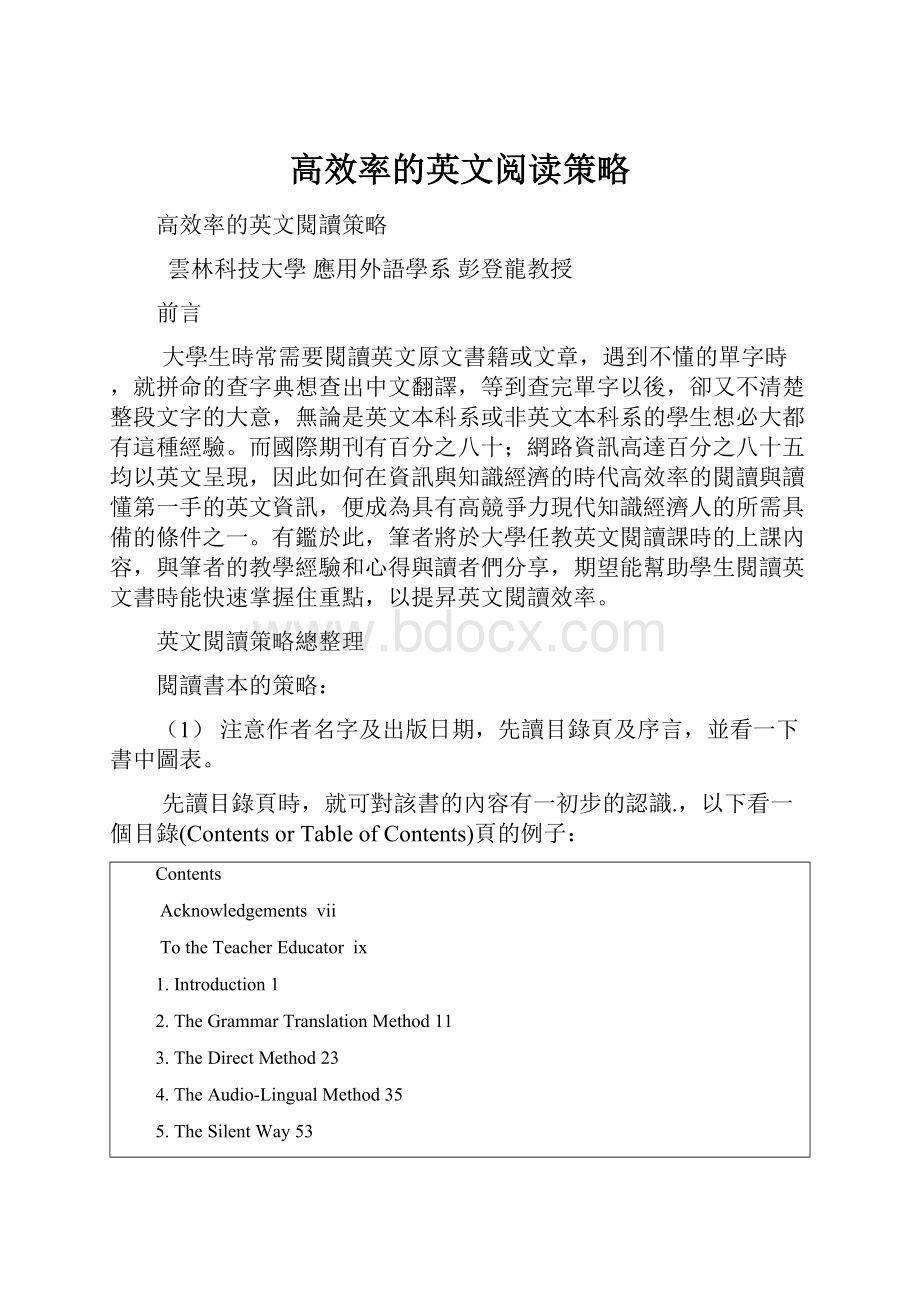高效率的英文阅读策略.docx
《高效率的英文阅读策略.docx》由会员分享,可在线阅读,更多相关《高效率的英文阅读策略.docx(20页珍藏版)》请在冰豆网上搜索。

高效率的英文阅读策略
高效率的英文閱讀策略
雲林科技大學應用外語學系彭登龍教授
前言
大學生時常需要閱讀英文原文書籍或文章,遇到不懂的單字時,就拼命的查字典想查出中文翻譯,等到查完單字以後,卻又不清楚整段文字的大意,無論是英文本科系或非英文本科系的學生想必大都有這種經驗。
而國際期刊有百分之八十;網路資訊高達百分之八十五均以英文呈現,因此如何在資訊與知識經濟的時代高效率的閱讀與讀懂第一手的英文資訊,便成為具有高競爭力現代知識經濟人的所需具備的條件之一。
有鑑於此,筆者將於大學任教英文閱讀課時的上課內容,與筆者的教學經驗和心得與讀者們分享,期望能幫助學生閱讀英文書時能快速掌握住重點,以提昇英文閱讀效率。
英文閱讀策略總整理
閱讀書本的策略:
(1)注意作者名字及出版日期,先讀目錄頁及序言,並看一下書中圖表。
先讀目錄頁時,就可對該書的內容有一初步的認識.,以下看一個目錄(ContentsorTableofContents)頁的例子:
Contents
Acknowledgementsvii
TotheTeacherEducatorix
1.Introduction1
2.TheGrammarTranslationMethod11
3.TheDirectMethod23
4.TheAudio-LingualMethod35
5.TheSilentWay53
6.Desuggestopedia73
7.CommunityLanguageLearning89
8.TotalPhysicalResponse107
9.CommunicativeLanguageTeaching121
10.Content-based,Task-based,andParticipatory
Approaches137
11.LearningStrategyTraining,CooperativeLearning,
andMultipleIntelligences159
12.Conclusion177
Appendix191
Source:
Larsen-Freeman,D.(2000).TechniquesandPrinciplesinLanguageTeaching.NewYork:
OxfordUniversityPress.
在細讀序言文章之前,先讀主題句(通常為每一段的第一句),了解其中的中心思想(main/centralidea),在序言中通常有一段(或數段)在介紹書本章節的安排與大概內容。
以下看一個序言(Introduction)的例子:
1Introduction
GOALSOFTHISBOOK
Oneofthegoalsofthisbookisforyoutolearnaboutmanydifferentlanguageteachingmethods….Theactionsarethetechniquesandthethoughtsaretheprinciplesinthetitleofthisbook:
TechniquesandPrinciplesinLanguageTeaching.
Asecondgoalistohelpyouuncoverthethoughtsthatguideyourownactionsasateacher….
Athirdgoalistointroduceyoutoavarietyoftechniques,someofwhichwillbenew….
LAYOUTOFCHAPTERS
Wewilllearnaboutthemethodsbyenteringaclassroomwhereeachmethodisbeingpracticed….
Wewillobservethetechniquestheteacherisusingandhisorherbehavior….
Afterwehaveidentifiedtheprinciples,wewillanswerthefollowingtenquestions:
1.Whatarethegoalsofteacherswhousethismethod.
2.Whatistheroleoftheteacher?
Whatistheroleofthestudents?
3.Whataresomecharacteristicsoftheteaching/learningprocess?
Theanswerstothesequestionswilladdtoourunderstandingofeachmethodandallowustoseesomesalientdifferencesamongthemethodspresentedhere….
Followingthesequestions,wewillreviewthetechniquesweobservedinthelesson….
Attheendofeachchapteraretwotypesofexercises…Teachingcanbeasolitaryact,butcollaboratingwithotherteacherscanhelpenrichourexperienceandnurtureourgrowth.
Source:
Larsen-Freeman,D.(2000).TechniquesandPrinciplesinLanguageTeaching.NewYork:
OxfordUniversityPress.
(2)瀏覽第一與最後一章之題目、標題、圖表等。
(3)瀏覽中間的章節,然後決定應該讀的章節。
(4)若有需要可先看一下書末的名詞解釋、主題索引、附錄。
閱讀文章段落的策略:
在細讀文章之前,先讀主題句(topicsentence)(通常為每一段的第一句),了解其中的中心思想(main/centralidea),再分析其闡述句/發展句(supporting/developmentsentences)中所運用的技巧,例如:
例證法/舉例法(exemplification)、時間順序法(chronologicalorder)、空間順序法(spatialorder)、因果法(causeandeffect)、比較或對比法(comparisonorcontrast)、分類法(classification)、定義法(definition)、過程分析法(processanalysis)、主題法(topicalorganization)、推理法(inference)、問題解決法(problem-solution)、綜合法(combinedmethod)等,譬如在時間順序法的文章中會讀到時間副詞(如:
年代、first,second/then,third,finally等),而在空間順序法的文章中會看到方位或地方副詞(如:
east,west,south,north),最後了解該段的結論句(通常為每一段的最後一句)。
所以欲瞭解一段文章的大意,只須先清楚主題句中的中心思想關鍵字(keywords),若遇有不懂的單字,將其查出,至於段落中不懂的單字可依字源學的概念:
即字根(wordroot/stem字的意義)、字首(prefix肯定/否定/方向/位置)、字尾(suffix詞性:
名詞/動詞/形容詞/副詞)與語境/前後文(context)來猜測即可,不用花費太多的時間查出每個不懂的單字。
另外要注意的是,英文段落中通常只有一個中心思想,此即為unity(單一性)原則。
英文段落的架構,以圖表的樣子呈現,有如下圖:
Topicsentence(includingmain/centralidea;it’susuallythefirstsentenceinabodyparagraph)….Supportingsentences(exemplification,chronologicalorder,spatialorder,causeandeffect,comparisonandcontrast,classification,definition,processanalysis,topicalorganization,inference,problem-solution,orcombinedmethod)….Concludingsentence(summaryofthewholeparagraph)….
以下以一段文章為例,說明閱讀文章段落的策略:
Thechoiceoftargetlanguageisdeterminedbyavarietyoffactors.InthecaseofimmigrantstoCanada,Britain,ortheUnitedStates,learningEnglishisprobablytheprimeobjective.Butinthecaseofforeignlanguageinstructioninschoolsanduniversities,thechoiceoflanguageandtheobjectivestobepursuedarelessclearlydefined.AlthoughthereareusuallygoodeducationalandsociopoliticalreasonsforincludingFrenchorGermanintheschoolcurriculum,studentsmayfindthatinlaterlifetheyneedRussian,Spanish,orArabic.Inothercases,oncetheyhavegrownup,studentsmakenofurtheruseofanyofthelanguagestheystudiedinschool.Therefore,especiallyinschoolanduniversitysettings,foreignlanguageteachingshouldincludeamongitsgoalsmoregeneralizededucationalobjectivesthanthosewehaveconsideredsofar.Thesecanbesummarizedasthree‘transfer’objectives:
acquiringlanguagelearningtechniques;obtaininginsightintolanguageandculture,anddevelopingpositivegeneralizedattitudestolanguage,culture,andlanguagestudy.
Source:
Stern,H.H.(1990).Allen,P.&Harley,B.(Eds.).IssuesandOptionsinLanguageTeaching.Toronto:
OxfordUniversityPress.(p.93)
主題句:
Thechoiceoftargetlanguageisdeterminedbyavarietyoffactors.
中心思想(關鍵字):
關鍵字choiceoftargetlanguage(目標語的選擇),中心思想是各種不同的因素決定目標語的選擇
闡述句策略:
接者作者用例證法(inthecaseof,inthecaseof,inothercases)來闡述其中心思想。
結論句:
Thesecanbesummarizedasthree‘transfer’objectives:
acquiringlanguagelearningtechniques;obtaininginsightintolanguageandculture,anddevelopingpositivegeneralizedattitudestolanguage,culture,andlanguagestudy.
大意:
目標語的選擇由各種不同的因素所決定,接者作者用例證法
(1)加拿大、英國或美國的移民;
(2)學校與大學的外語教學;(3)學生長大來闡述其中心思想。
最後作者以結論句來總結三個轉移的目標:
(1)習得語言學習的技術;
(2)獲得語言語文化的洞察力;(3)發展對語言、文化、語言研究的一般正面態度。
文章段落各種類型整理:
接著各以一段文章,介紹各種不同類型的闡述句中所運用的技巧:
1、例證法/舉例法(Exemplification)
所謂例證法就是使用例子(如自己、別人)來說明要討論的意見,這是最常見也是最有效的說明文。
Thisbookisaddressedtosecondorforeignlanguageteachersingeneral.Itisnotspecifictoanyonelanguageandthereforeconcerns,forexample,theteacherofEnglishasasecondlanguage(ESL)orEnglishasaforeignlanguage(EFL)asmuchastheteacherofFrench,Spanish,Russian,orJapanese.Thebookisalsogeneralinanothersense.Itisnotonlymeantforteacherswhoworkinaparticulartypeofinstruction,suchasacomprehensiveschool,highschool,orgrammarschool;ithasinmindequallytheteacherofyoungchildrenaswellasofadultlearners;itrangesfromkindergartentouniversity;itisforteachersofstudentswhoaretaughtinformallythroughprivatetuitionorformallyinconventionalclassesoften,twenty,orthirtypupils;itisalsomeantforteacherwhoreachmassaudiencesthroughradioortelevision.Itshouldbeofinteresttoteachertrainers,supervisors,administrators,andotherswhosebusinessissecondorforeignlanguageteachingorsomeaspectofit.
Source:
Stern,H.H.(1990).Allen,P.&Harley,B.(Eds.).IssuesandOptionsinLanguageTeaching.Toronto:
OxfordUniversityPress.(p.1)
主題句:
Thisbookisaddressedtosecondorforeignlanguageteachersingeneral.
中心思想(關鍵字):
secondorforeignlanguageteachers
闡述句策略:
例證法(forexample,suchas)
結論句:
Itshouldbeofinteresttoteachertrainers,supervisors,administrators,andotherswhosebusinessissecondorforeignlanguageteachingorsomeaspectofit.
大意:
一般而言,這本書是寫給第二或外語的教師。
接著,作者說明亦適用於其他的教師,舉例
(1)ESL/EFL教師、法語/西班牙語/俄語/日語教師;
(2)綜合學校、高中、文法學校的教師。
最後,作者說明此書對師訓人員、指導員、行政人員或其他從事第二或外語的教師亦有用。
例證法/舉例法常用字/片語:
forexample,forinstance,inthiscase,inanothercase,onthisoccasion,inthissituation,takethecaseof,proofofthis,evidenceofthis,thus,inthismanner,inotherwords.,suchas,thatis,case,specifically,generally,asproof,asfollows,asbelow,tonameafew,tobespecific
2、時間順序法(ChronologicalOrganization)
所謂時間順序法就是以時間的先後順序(如年代、西元年)來說明人物或事件發展的經過。
Animportantdevelopmentinthewakeofthescientificmovementwastheincreasinguseofempiricalresearchmethodsintheattempttosolveproblemsoflanguagepedagogy.The1960switnessedvigorousattemptstocometogripswiththemethodcontroversythroughempiricalresearch.Severalresearchprojectswereinitiatedwiththispurposeinmind.Theywereonlypartiallysuccessfulinthattheevidencetheyproducedforoneortheothermethodologicaloptionwasnotveryconclusive.Thesestudiesgaverisetofurthercontroversies,andtheresearchersweredrawnintothedebate.Inthe1970s,researchersabandonedthecentralemphasisonteachingmethodand,asalreadymentioned,initiatedanewandproductiveseriesofstudiesonlanguagelearning.Thoseexploringthisavenuearguedforcefullythatnoimprovementinlanguageteachingcouldbeexpectedunlessthecharacteristicsofsecondlanguagelearnersandthelearningprocesswerebetterunderstood.Manystudiesinthe1970sandthe1980swerecarriedoutwiththisobjectiveinmind.Graduallyalsoresearchonlanguageteachingwastriedagain,butthistimemorecautiouslyandwithgreatersophistication,andwithmoresafeguardstoensurevalidity.
Source:
Stern,H.H.(1990).Allen,P.&Harley,B.(Eds.).IssuesandOptionsinLanguageTeaching.Toronto:
OxfordUniversityPress.(p.9)
主題句:
Animportantdevelopmentinthewakeofthescientificmovementwastheincreasinguseofempiricalresearchmethodsintheattempttosolveproblemsoflanguagepedagogy.
中心思想(關鍵字):
empiricalresearchmethods,solveproblemsoflanguagepedagogy
闡述句策略:
時間順序法(1960s,1970s,1980s)
結論句:
Graduallyalsoresearchonlanguageteachingwastriedagain,butthistimemorecautiouslyandwithgreatersophistication,andwithmoresafeguardstoensurevalidity.
大意:
隨著科學運動尾隨而至的一項重要發展,就是越來越多人使用實證的研究方法,試著解決語言教學論的問題。
接著,作者使用時間順序法說明三個年代的嘗試:
(1)1960年代時,研究人員透過實證研究勉力對付方法的爭論;
(2)1970年代時,研究人員放棄只強調教學法的觀念,而對語言學習方面開始實施一系列創新的研究;(3)1970年代與1980年代時,研究人員開始重視第二語言學習者與